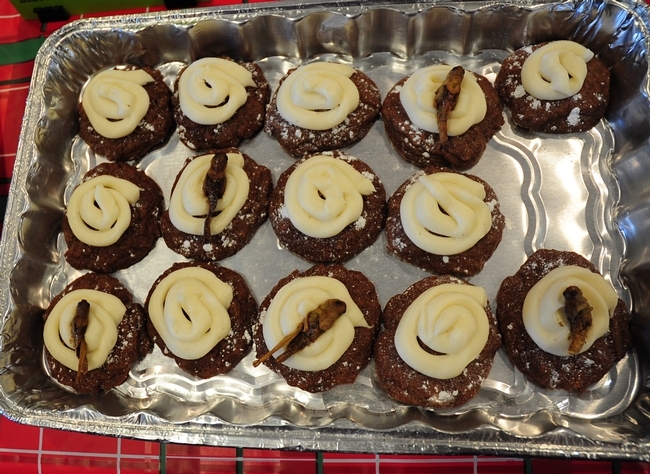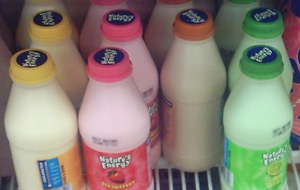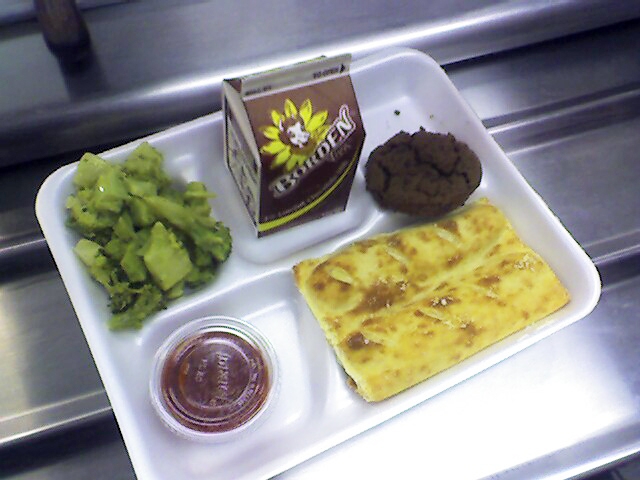
Posts Tagged: chocolate
If You Like Chocolate, Thank the Midges!
If you like chocolate, thank the midges. These tiny flies (about 1 to 3mm) pollinate the intricate flowers of the cacao tree, Theobroma cacao. From those seed pods, known as cocoa beans, come the chocolate that we crave. In fact, we Americans consume 2.8 billion pounds of chocolate every year, or...

Ernesto Sandoval, collections manager for the UC Davis Botanical Conservatory, checks out the cacao tree, aka "chocolate tree." (Photo by Kathy Keatley Garvey)
Please Pass the Chocolate Chirp Cookies
Bugs: they're what's for dinner! Well, at some dinners. In. Many. Parts. Of. The. World. Distinguished professor Bruce Hammock of the UC Davis Department of Entomology and Nematology and UC Davis Comprehensive Cancer Center just shared with us "Bugs: They're What's for Dinner!" (not the bugs, the...

Chocolate Chirp Cookies, the work of Heather Baker, UC Davis graduate student studying malaria mosquitoes. (Photo by Kathy Keatley Garvey)

UC Davis Department of Entomology and Nematology cookie social! From left: account manager Guyla Yoak, contest coordinator; and winners Elvia Mayes, account manager; Steve Nadler, professor and chair of the department; Heather Baker, graduate student/mosquito researcher of the Shirley Luckhart lab; Stacey Rice, junior specialist of the Larry Godfrey lab; and Mimi Portilla, graduate student/mosquito researcher of the Sharon Lawler lab. (Photo by Kathy Keatley Garvey)
The great flavored milk debate

There has been much talk about flavored milk in recent months, and much of this debate has been fueled by Jamie Oliver who has a popular television show, Jamie Oliver’s Food Revolution, on ABC. His goal is simple: "To revolutionize school lunches to save the health of America’s next generation." Oliver launched a “sugary milk campaign” back in April, 2011. The purpose of the campaign is to ask schools to promote plain white milk instead of flavored milks. According to Oliver’s website, “chocolate milk has the same amount of sugar as a soft drink and just one additional soft drink per day increases a child’s obesity risk by 60 percent and is a major contributor to Type 2 diabetes.”
Well before Oliver emerged on the scene, people have debated the merits of offering flavored milk in the school lunch program. Chocolate (the most common), strawberry, vanilla and other interesting flavors are widely available in districts across the country. The milk provides essential nutrients, but with that comes added sugars that contribute extra calories to the diet – something most American children do not need.
Is there a place for flavored milk on the school lunch tray?
According to the American Dietetic Association, the Dairy Council and other health and nutrition organizations – the answer is yes.
Supporters of flavored milk in schools argue that it provides nine essential nutrients – unlike sodas and other sweetened beverages that offer no nutritional benefit besides extra calories.
According to the American Dietetic Association, leading health and nutrition organizations (including the American Academy of Family Physicians, American Academy of Pediatrics, American Heart Association, National Hispanic Medical Association, National Medical Association and School Nutrition Association) recognize the role that low-fat or fat free milk (including flavored milk) plays in helping kids achieve daily dairy serving recommendations. According to the ADA, kids will drink more milk when it’s flavored and kids drink less milk (and get fewer nutrients) when flavored milk is taken away.
The Diary Council offers an overview for school nutrition professionals in favor of flavored milk on the lunch tray. The Dairy Council of California argues that we cannot forget flavored milk has both natural sugars (lactose) and added sugar, and the amount of high-fructose corn syrup added to flavored milk is much less than the amount added to sugary beverages like soda or other processed foods. Additionally, some studies suggest that kids who drink flavored milk are less likely to consume soda and other sugary beverages, they consume more nutrients and are more likely to maintain a healthy body weight.
Where does LAUSD, the school district placed at the center of this debate, stand?

The burning question we all want to know the answer to now is, will LAUSD students switch over to low fat or fat free plain milk when chocolate or strawberry milk is no longer available in the fall? The answer will be very interesting and perhaps will put an end to the great flavored milk debate!
Depressed people eat more chocolate

The scientists examined the relationship between chocolate and mood among 931 women and men who were not using antidepressants. Their surprising conclusion: Participants who screened positive for possible depression ate an average of 8.4 servings of chocolate per month; those who weren't depressed ate on average 5.4 servings per month.
People who reflected major depression ate an average of 11.8 servings per month. What does that say about people like me who eat 30 or more servings of chocolate every month? It is depressing to contemplate.
The study's authors offered some possible explanations for the seeming correlation of chocolate consumption with depression:
- Depression could stimulate chocolate cravings as 'self-treatment'
- Depression may stimulate chocolate cravings for other reasons
- Chocolate could contribute to depressed mood
- Inflammation could drive both depression and chocolate cravings
If you are looking for some good news associated with chocolate consumption, go to the UC ANR website Feeling Fine Online and view the 15-minute video of UC Davis nutrition professor Carl Keen explaining the health benefits chocolate.
According to Keen, a diet high in flavanols, such as those in chocolate, can reduce inflammatory conditions associated with cardio vascular disease, vasoconstriction and the risk of forming a blood clot.
A new study indicates that flavanols may increase a population of certain cells in the blood that scientists think help repair the inner walls of blood vessels, improving blood flow and potentially lowering blood pressure. This suggests that, in the future, isolated flavanols or flavanol-rich foods might be useful in preventing or possibly even treating coronary artery disease. For more information, read the UC Davis College of Agricultural and Environmental Sciences story Flavanol-rich foods may help heart disease patients, study suggests.
(Ann King Filmer contributed to this story.)

iStockphoto
Move over, Mrs. Fields
Move over, Mrs. Fields. Make way for Mrs. Miller. “Mrs. Miller’s Chocolate Chip Cookies,” that is.
“Mrs. Miller’s Chocolate Chip Cookies” scored a big hit at the annual Solano County 4-H Presentation Day, held in Fairfield.
Caitlin Miller, 10, of Vacaville, a member of the Elmira 4-H Club, chose to give a presentation on a cookie she loves the most: her grandmother’s chocolate chip cookies.
Her grandmother, Alice Miller, of Washington state, formerly of Benicia, “makes them all the time,” Caitlin said. “She showed me how to make them and they’re really good.”
The secret ingredient, cream cheese, keeps them soft.
The two judges, Sally Moore of the Roving Clovers 4-H Club, Dixon and Sarah San Nicolas of the Golden Hills 4-H Club, Vacaville, proclaimed the cookies “delicious.” They gave a blue (very good) award for her presentation.
Caitlin, a fourth grader at Cooper School in Vacaville, posted the recipe on her display board, complete with photos of the entire process.
She said she enjoyed making them.
Probably not as much as the crowd at the Solano County 4-H Presentation Day enjoyed eating them. Within a matter of minutes, not a crumb remained on the platter.
Here’s the recipe:
Mrs. Miller’s Chocolate Chip Cookies
1 cup butter
4 ounces cream cheese
1 cup brown sugar
3/4 cup granulated sugar
1 egg
2 teaspoons vanilla
2-1/2 cups flour
1 teaspoon salt
1 teaspoon baking soda
1 teaspoon baking powder
12 ounces chocolate chips, semi-sweet
1 cup of nuts (optional)
Preheat oven to 375 degrees. Soften cream cheese and butter. Blend with brown sugar and granulated sugar until smooth. Add egg and vanilla and blend. Add flour, salt, baking soda, baking powder and mix. Then add chocolate chips, and if desired, nuts.
Using an ice cream scoop, place on an ungreased cookie sheet. Flatten dough slightly. Bake at 375 degrees for 12 to 14 minutes (until lightly golden).

Caitlin Miller
